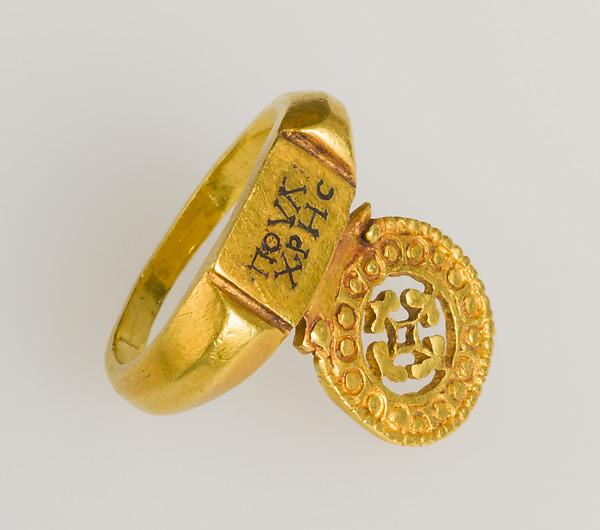
Object Title
Roman Key Ring with Inscription
Measurements
Overall: 7/8 × 15/16 × 11/16 in., 0.478oz. (2.2 × 2.4 × 1.8 cm, 13.55g) Bezel: 7/8 × 9/16 × 1/16 in. (2.2 × 1.4 × 0.2 cm) Inside circumference: 2 3/8 in. (6 cm)
Creation Date
4th century
Credit Line
Gift of Taylor L. Thomson, 2016
Museum Name
Culture
Country of Origin
Object Type
Materials / Techniques
Object URL
http://www.metmuseum.org/art/collection/search/681657
Provenance Information
Collection of Benjamin Zucker, New York (by 1985–2014); Taylor Thomson, Los Angeles and Toronto, Canada [purchased through Les Enluminures Ltd.] (2014–2016); given by Taylor Thomson to The Metropolitan Museum of Art (2016).
Exhibition Information
Exhibited in Cycles of Life: Rings from the Benjamin Zucker Family Collection, the exhibition of the Zucker Collection held at Les Enluminures Ltd., New York, October 30, 2014–December 6, 2014.
It was subsequently shown in the exhibition entitled, Treasures and Talismans: Rings from the Griffin Collection on view at The Met Cloisters, May 1 2015–October 18, 2015.
It was subsequently shown in the exhibition entitled, Treasures and Talismans: Rings from the Griffin Collection on view at The Met Cloisters, May 1 2015–October 18, 2015.
Publication Information
Sandra Hindman with Beatriz Chadour-Sampson, Riene Hadjadj, Jack Odgen and Diana Scraisbrick, Cycles of Life: Rings from the Benjamin Zucker Collection (London: Paul Holberton Publishing, 2014), cat. 8, pp. 70-73; Diana Scarisbrick, Rings: Jewelry of Love, Power, and Loyalty (London: Thames and Hudson, 2007), p. 61, no. 77.
Section of the AAMD Guidelines relied upon for the exception to 1970
Cumulative facts and circumstances
Explain why the object fits the exception set forth above
This work has provenance confirmed to 1985, when it was placed on deposit, but not displayed, at the Walters Art Museum from 1985 to 2014. This work has been exhibited and published twice. This ring is especially significant for its status as the only early Byzantine marriage ring in the collection and for its linkage of the Roman and Byzantine cultures of late antiquity, when Christianity emerged as the dominant religion of the ruling classes.